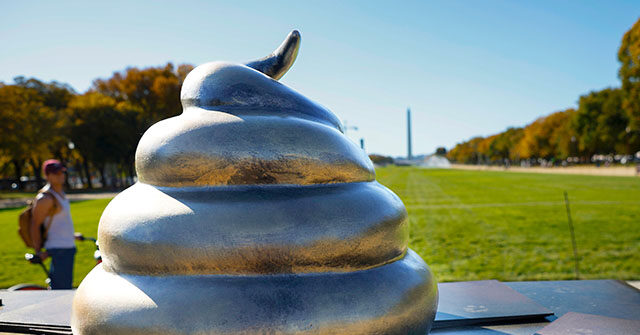On January 6, 2021, a controversial event unfolded at the U.S. Capitol, leading to the installation of a giant “poop” statue designed to satirically memorialize that day. The art piece, shaped like a soft-serve ice cream cone, sits on a scaled replica of House Speaker Nancy Pelosi’s desk and aims to provoke thought about the actions taken during the Capitol riot. Its accompanying plaque highlights the defiance exhibited by those who stormed the Capitol, describing their actions as an attempt to overturn the election results, and sarcastically labels them as “heroes” and “patriots” in the context used by former President Donald Trump. The statue is positioned prominently near the National Mall, right in front of the Capitol, creating a poignant juxtaposition with the building’s significance.
Julia Jimenez-Pyzik, representing Civic Crafted LLC, obtained the necessary permits from the National Park Service (NPS), which confirmed that the installation would be on display until October 30. The NPS indicated that it does not evaluate the content of public art installations when issuing permits, underlining the importance of the First Amendment rights of citizens to express their views in public spaces. This approach reflects a broader institutional commitment to facilitating free expression, even when the artworks might provoke controversy or mixed emotions within the communities involved.
As visitors encountered the statue, reactions varied widely, reflecting the polarized views on the events of January 6 and their aftermath. Some pedestrians expressed approval, seeing the artwork as a stark representation of the somber reality and chaos that unfolded during the insurrection. Jon Golinger, for instance, articulated that the statue provides an impactful commentary that helps people remember the day’s events and their significance for American democracy. However, others felt conflicted about the piece’s appropriateness, finding its satirical tone problematic when reflecting on what they consider a tragic chapter in U.S. history.
Among critics of the installation was Dan Thayer, who experienced the events of January 6 firsthand while seeking shelter during the chaos. He noted his appreciation for the sarcastic nature of the art but struggled with reconciling that humor with the profound sadness the riot inspired. Such mixed feelings underscore the often emotional and contentious legacy of January 6, highlighting how art can serve both as a mechanism for reflection and a flashpoint for divided opinions.
Responses also surfaced from those who align politically with former President Trump, including Janis Grout, a visitor from Oregon. She expressed her belief that the statue’s presence was unwarranted in such a historic and esteemed setting, viewing it as a disruption to the dignity of the National Mall. This highlights a persistent divide along partisan lines regarding how past events should be commemorated or critiqued, suggesting that public art’s role is often intertwined with individual political beliefs and cultural values.
Ultimately, the giant statue serves as both a provocation and a commentary on a defining moment in American history. It acts to catalyze discussions about democracy, free speech, and the complexities of national memory in the face of political turmoil. As the installation remains on view for months, it will likely continue to elicit varied responses and challenge observers to confront the realities and implications of the January 6 insurrection in their own ways. This interplay between art, politics, and public sentiment encapsulates a crucial aspect of civic engagement in contemporary America, showcasing how expressions of dissent and reflection can take tangible form in the nation’s capital.

